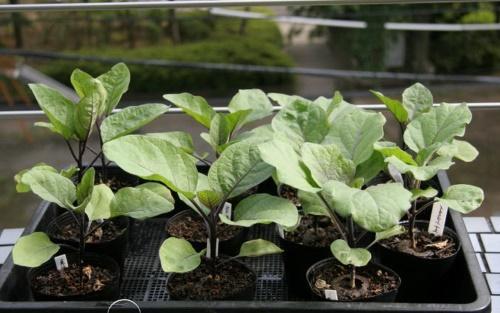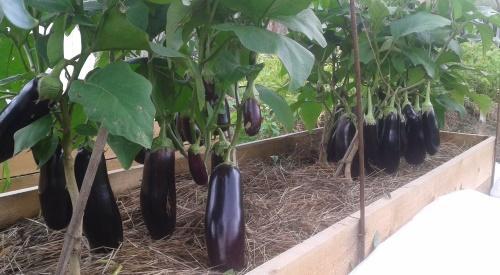How to grow eggplants: important nuances of planting and care
 Eggplants are not found in every garden. Unlike peppers, which can easily grow with little or no human intervention, blue peppers are more demanding. First of all, it concerns temperature. Our sometimes too hot summer does not contribute to the growth of culture in any way and is even contraindicated for it. Bushes do not bear fruit even when the summer is cold. Watering is also worth mentioning: it is important to find a middle ground. Eggplants do not like both lack of moisture and its excess. And they also absolutely cannot stand drafts and wind. So gardeners do not risk thinking how to grow eggplants if they are so capricious. However, not everything is so scary and difficult. It is quite possible to get a harvest if you create suitable conditions for the eggplants and follow our recommendations.
Eggplants are not found in every garden. Unlike peppers, which can easily grow with little or no human intervention, blue peppers are more demanding. First of all, it concerns temperature. Our sometimes too hot summer does not contribute to the growth of culture in any way and is even contraindicated for it. Bushes do not bear fruit even when the summer is cold. Watering is also worth mentioning: it is important to find a middle ground. Eggplants do not like both lack of moisture and its excess. And they also absolutely cannot stand drafts and wind. So gardeners do not risk thinking how to grow eggplants if they are so capricious. However, not everything is so scary and difficult. It is quite possible to get a harvest if you create suitable conditions for the eggplants and follow our recommendations.
Let's start with seedlings: no picking!

To avoid this situation, sow seeds only in separate cups. The grown seedlings are transplanted into open ground only by the transfer method. It is impossible to free it from the soil and disturb the roots.
How to grow eggplant warm
 In order for the bushes to actively build up their mass and set fruits, their roots must be warm. It is possible to plant seedlings in the garden only when the earth warms up to 20 degrees Celsius. In the future, it will help to maintain the optimal temperature warm beds.
In order for the bushes to actively build up their mass and set fruits, their roots must be warm. It is possible to plant seedlings in the garden only when the earth warms up to 20 degrees Celsius. In the future, it will help to maintain the optimal temperature warm beds.
Maintaining humidity in the beds
 Eggplants are moisture-loving, and it is impossible to allow the earth to dry out into stone. In hot summer, especially in the absence of rain, they will need to be watered daily. Moreover, it is better to do this in the evening, using water heated during the day in containers and directing the stream to the root.
Eggplants are moisture-loving, and it is impossible to allow the earth to dry out into stone. In hot summer, especially in the absence of rain, they will need to be watered daily. Moreover, it is better to do this in the evening, using water heated during the day in containers and directing the stream to the root.
To retain moisture and maintain its uniform evaporation, the beds must be mulched without fail. In this case, it will be enough to water them once every 5-7 days.
Protecting plants from the wind
 When choosing a place for planting eggplant, you need to stay in a well-lit area, but which is not blown out. If there is none, then you need to artificially protect the plants from drafts. Coated arcs are installed over the beds. On the one hand, it is fixed, and the other rises for access to sunlight.
When choosing a place for planting eggplant, you need to stay in a well-lit area, but which is not blown out. If there is none, then you need to artificially protect the plants from drafts. Coated arcs are installed over the beds. On the one hand, it is fixed, and the other rises for access to sunlight.
We provide additional nutrition for eggplants
 The blue ones are very "gluttonous", and you cannot see a good harvest without additional feeding. The supply of nutrients is enough for them only at the initial stage. For the formation and maturation of the ovary, it is necessary to apply fertilizers:
The blue ones are very "gluttonous", and you cannot see a good harvest without additional feeding. The supply of nutrients is enough for them only at the initial stage. For the formation and maturation of the ovary, it is necessary to apply fertilizers:
- 3 weeks after disembarkation - infusion of chicken droppings or mullein;
- hereinafter referred to as phosphate preparations.
Bushes also respond well to the introduction of wood ash once a month.
We form strong bushes
 Since the fruits of the eggplant are large enough, the bush itself must be powerful. Not all shoots (stepchildren) give ovary, but they draw juices from the plant. They need to be removed. Leaves are also broken out, which prevent the sun from entering the bush. In tall varieties, it is recommended to pinch the tops after the bush reaches a height of 30 cm.
Since the fruits of the eggplant are large enough, the bush itself must be powerful. Not all shoots (stepchildren) give ovary, but they draw juices from the plant. They need to be removed. Leaves are also broken out, which prevent the sun from entering the bush. In tall varieties, it is recommended to pinch the tops after the bush reaches a height of 30 cm.